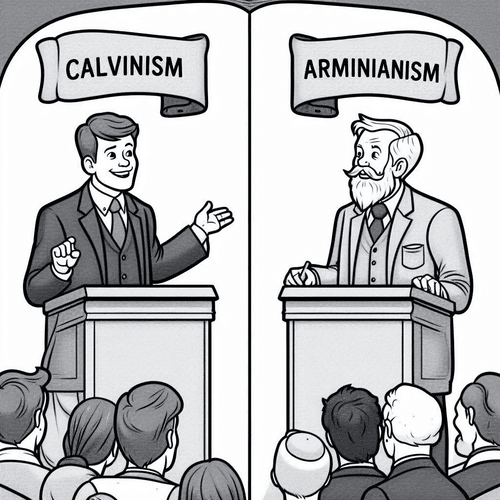‘The Abomination of Desolation’: Already Fulfilled or Yet to Come?
Few Bible prophecies have captured Christian imagination quite like Daniel’s vision of “the abomination that causes desolation.” The mysterious phrase appears three times in Daniel’s prophecies and receives Jesus’ own endorsement in the Olivet Discourse. But what exactly did Daniel see, and has it already come to pass?
The prophecy sits at the heart of debates about biblical interpretation, the timing of Christ’s return, and how we understand God’s plan for history. For Reformed Christians, the answer provides both scholarly confidence and pastoral comfort: God’s prophetic word has been faithfully fulfilled in history, demonstrating His absolute sovereignty over human events.
THE BIBLICAL FOUNDATION: WHAT SCRIPTURE ACTUALLY SAYS
Daniel’s Three Key Passages:
- Daniel 9:27: “In the middle of the week he will put an end to sacrifice and offering. And at the temple he will set up an abomination that causes desolation, until the end that is decreed is poured out on him.”
- Daniel 11:31: “His armed forces will rise up to desecrate the temple fortress and will abolish the daily sacrifice. Then they will set up the abomination that causes desolation.”
- Daniel 12:11: “From the time that the daily sacrifice is abolished and the abomination that causes desolation is set up, there will be 1,290 days.”
Jesus’ Confirmation in Matthew 24:15:
- Matthew 24:15: “So when you see standing in the holy place ‘the abomination that causes desolation,’ spoken of through the prophet Daniel—let the reader understand—then let those who are in Judea flee to the mountains.”
The Hebrew phrase shiqquts meshomem literally means “detestable thing causing horror” or “disgusting thing that devastates.” This wasn’t merely ritual impurity—Daniel foresaw something offensive to God: that it would bring devastating judgement upon the holy place itself.
The Historical Context: Daniel received these visions during the Babylonian exile, when the temple lay in ruins and God’s people wondered if His promises would ever be fulfilled. The prophecies assured them that while greater tribulations lay ahead, God remained sovereign over history and would ultimately vindicate His people.
PRIMARY REFORMED INTERPRETATIONS: THREE APPROACHES
The Preterist View: History Validates Prophecy The majority of Reformed scholars see this prophecy as historically fulfilled, pointing to two dramatic events that perfectly match Daniel’s descriptions.
First Fulfillment—Antiochus IV Epiphanes (167 BC): Antiochus IV, the Syrian-Greek ruler, represents one of history’s most precise prophetic fulfilments. Daniel 11:21-35 describes this “contemptible person” with stunning accuracy:
- He seized power through intrigue rather than rightful inheritance
- He invaded Egypt twice but was turned back by Roman intervention (“ships of Kittim”)
- Most significantly, he desecrated Jerusalem’s temple by erecting an altar to Zeus Olympus and sacrificing pigs on it
- He banned Jewish sacrifices, outlawed Torah observance, and persecuted faithful Jews
- His persecution lasted approximately 3.5 years (1,290 days), ending when Judas Maccabeus cleansed and rededicated the temple in 164 BC
The historical evidence is overwhelming. First and Second Maccabees provide detailed contemporary accounts, and even secular historians acknowledge the remarkable precision of Daniel’s prophecy.
Second Fulfillment—Roman Destruction (AD 70): Jesus expanded Daniel’s prophecy to include the Roman destruction of Jerusalem under General Titus. The Jewish historian Josephus describes Roman soldiers setting up their standards (bearing pagan symbols) in the holy place and offering sacrifices to their gods. This final “abomination” ended the temple system forever.
Jesus warned His disciples to flee Jerusalem when they saw these signs—and early church historians record that Christians heeded this warning and escaped to Pella before the final siege.
The Partial Preterist View: Type and Fulfillment Some Reformed theologians, including John Calvin, saw Antiochus as a “type”—a historical pattern pointing to the greater fulfilment in AD 70. This view recognises biblical prophecy as often working in layers, with near-term fulfilments foreshadowing ultimate realities.
Jesus’ warning in Matthew 24 serves as the bridge between these fulfilments. He acknowledged Daniel’s prophecy while applying it to the coming Roman destruction, demonstrating how Old Testament prophecy finds its ultimate meaning in relation to Christ and His work.
This approach maintains the historical grounding of Reformed interpretation. It also recognises the rich typological patterns that connect Old and New Testament events.
The Idealist View: Ongoing Spiritual Pattern A minority of Reformed interpreters see the abomination as representing an ongoing pattern throughout church history—the persistent tendency of worldly powers to oppose God’s people and corrupt true worship.
This view emphasises the spiritual dimensions of the prophecy rather than focusing on specific chronological fulfilments. It finds application in various historical periods when the church faced persecution and when false teaching corrupted pure doctrine and worship.
While less historically specific, this approach captures important theological truths about the ongoing conflict between the kingdom of God and worldly powers.
THEOLOGICAL IMPLICATIONS: WHAT THIS MEANS FOR US
- God’s Sovereignty Over History: These fulfilments demonstrate that no human empire, however powerful, operates outside God’s sovereign control. Even pagan rulers like Antiochus and Titus unknowingly carried out God’s prophetic plan.
- Covenant Faithfulness and Judgement: The prophecies reveal God’s justice in judging covenant unfaithfulness while preserving a faithful remnant. Both the Maccabean period and AD 70 destruction followed patterns of apostasy and rebellion against God’s law.
- Christ as Ultimate Fulfilment: The end of the temple system in AD 70 confirmed that Jesus had become the ultimate temple and sacrifice. The old covenant order, with its sacrifices and ceremonies, gave way to the new covenant reality in Christ.
- Church as New Temple: Paul teaches that the church is now God’s temple (1 Corinthians 3:16, Ephesians 2:21). This shifts our focus from physical buildings to spiritual realities—the purity of doctrine, worship, and community life.
- Reliability of Prophecy: The precise historical fulfillment of these prophecies provides unshakeable confidence in God’s faithfulness to His word. If God fulfilled these complex predictions exactly as foretold, we can trust His promises about Christ’s return and final victory.
- Comfort in Tribulation: The pattern of preservation through persecution encourages Christians facing opposition. Just as God protected Daniel through Babylonian captivity and preserved faithful Jews through Antiochus’ persecution, He sustains His people through every trial.
CONCLUSION: CONFIDENCE IN GOD’S FAITHFULNESS
Reformed theology’s historical approach to the abomination of desolation provides both scholarly rigor and pastoral comfort. Rather than endless speculation about future scenarios, we can point to concrete historical events that validate God’s prophetic word with stunning precision.
This perspective encourages us to study history as the stage where God’s sovereignty plays out, to find comfort in His proven faithfulness, and to live with confidence that the same God who fulfilled these ancient prophecies continues to work all things according to His perfect plan.
The abomination of desolation isn’t a puzzle waiting to be solved—it’s a testimony to God’s reliability that has already been written in history’s pages.
THE ABOMINATION OF DESOLATION: RELATED FAQs
Which Reformed scholars have held each of the three main interpretations? The Preterist View (complete historical fulfillment) has been championed by John Lightfoot (17th century), RC Sproul, Kenneth Gentry, and contemporary scholars like David Chilton and Gary DeMar. The Partial Preterist View (Antiochus as type, AD 70 as fulfillment) was held by John Calvin, Matthew Poole, Matthew Henry, and is supported today by Sinclair Ferguson, Dale Ralph Davis, and Tremper Longman III. The Idealist View (ongoing spiritual pattern) has fewer prominent advocates but includes William Hendriksen in his approach to Revelation. Most mainline Reformed denominations officially lean toward partial preterism.
- How do non-Reformed Christians interpret ‘the abomination of desolation’? Dispensationalist evangelicals typically tend toward a futurist view—that the abomination will occur when a future Antichrist desecrates a rebuilt temple during a seven-year tribulation period. This interpretation gained popularity through the Scofield Bible and prophecy books like the Left Behind series, but Reformed scholars reject it as speculative and unsupported by solid biblical interpretation. The Catholic tradition generally aligns with historical fulfillment but emphasises ongoing spiritual applications in liturgy and church life. Other scholars also see the prophecies as written during the Maccabean period (2nd century BC) to encourage Jews under Antiochus’s persecution; these scholars view them as historical commentary rather than supernatural prediction.
- Should Christians expect a rebuilt temple in Jerusalem? Reformed theology teaches Christ’s work made the Old Testament temple system obsolete, as demonstrated by the tearing of the temple veil at His crucifixion and the final destruction in AD 70. The New Testament clearly identifies Jesus as the ultimate temple (John 2:19-21) and the church as God’s new temple (1 Corinthians 3:16, Ephesians 2:19-22). A rebuilt physical temple would represent a step backward from the spiritual reality we have in Christ. Additionally, the precise genealogical records necessary for a legitimate Levitical priesthood were destroyed in AD 70, making a truly biblical temple system impossible to restore.
How do we interpret the “70 weeks” prophecy in Daniel 9? Most Reformed interpreters see the 70 weeks (490 years) as fulfilled in the period from the decree to rebuild Jerusalem (around 458 BC under Artaxerxes) to Christ’s first coming and the destruction of Jerusalem. The “one week” in verse 27 refers either to Christ’s earthly ministry (confirming the covenant) or the final period leading to AD 70. Reformed scholars reject the dispensationalist “gap theory” that places the 70th week in a future tribulation period, arguing that Daniel presents the weeks as consecutive without interruption. This interpretation maintains the prophecy’s historical integrity while pointing to Christ as its ultimate fulfillment.
- What about the mathematical problems with dating Daniel’s prophecy? Reformed scholars acknowledge that calculating exact dates from Daniel’s prophecy involves complexities regarding different calendar systems, starting points for the decree, and whether the years are lunar or solar. However, they argue that the prophecy’s primary purpose was to provide hope during exile and point to the Messiah’s coming, not to serve as a precise mathematical formula. The remarkable correspondence between the prophecy’s general timeframe and historical events (Antiochus’s persecution, Christ’s ministry, Jerusalem’s destruction) demonstrates divine inspiration without requiring calendar precision. God’s sovereignty in history matters more than our ability to calculate exact dates.
- How does this prophecy relate to modern Israel and current Middle East events? Reformed theology distinguishes between ethnic Israel and the people of God, teaching that the church has become the true Israel through faith in Christ (Romans 9-11, Galatians 6:16). While God may have purposes for ethnic Israel in history, the specific covenant promises and temple prophecies find their fulfillment in Christ and His church, not in modern political developments. Reformed Christians should support justice and peace in the Middle East without reading current events as direct fulfilments of biblical prophecy. The focus should remain on the Gospel going to all nations, including both Jews and Arabs.
Did Jesus predict the temple’s destruction accurately, and how do we know? Historical evidence strongly supports that Jesus predicted Jerusalem’s destruction before it happened in AD 70, contrary to critical scholars who claim the Gospels were written after the fact. Early church fathers like Clement of Rome (writing around AD 96) reference the destruction as a past event that fulfilled Jesus’ prophecy, and the specific details Jesus gave (Luke 21:20-24) match Josephus’s eyewitness accounts precisely. Additionally, the fact that early Christians escaped Jerusalem by fleeing to Pella (as church historians record) suggests they took Jesus’ warnings seriously before the siege began. This demonstrates both Christ’s prophetic authority and the reliability of Gospel transmission.
THE ‘ABOMINATION OF DESOLATION’: RELATED FAQs
Editor's Pick

The Throne-Room Vision: Who Did Isaiah See?
The scene is unforgettable: Isaiah stands in the temple, and suddenly the veil between heaven and earth tears open. He [...]

The Angel of the Lord: Can We Be Certain It Was Christ All Along?
Throughout the Old Testament, a mysterious figure appears: the Angel of the LORD. He speaks as God, bears God’s name, [...]
SUPPORT US:
Feel the Holy Spirit's gentle nudge to partner with us?
Donate Online:
Account Name: TRUTHS TO DIE FOR FOUNDATION
Account Number: 10243565459
Bank IFSC: IDFB0043391
Bank Name: IDFC FIRST BANK






